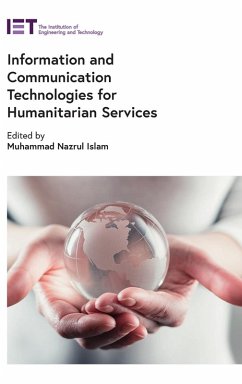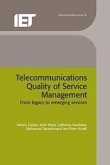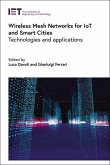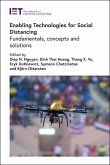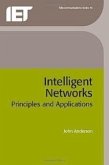Information and Communication Technologies for Humanitarian Services
Herausgeber: Nazrul Islam, Muhammad
Information and Communication Technologies for Humanitarian Services
Herausgeber: Nazrul Islam, Muhammad
- Gebundenes Buch
- Merkliste
- Auf die Merkliste
- Bewerten Bewerten
- Teilen
- Produkt teilen
- Produkterinnerung
- Produkterinnerung
Information, mobile and networking applications foster information exchange and cooperation in the humanitarian and emergency management fields. This edited book covers developments, innovations, and research outcomes for the creation and deployment of ICT technologies and solutions supporting humanitarian services.
Andere Kunden interessierten sich auch für
![Telecommunications Quality of Service Management: From Legacy to Emerging Services Telecommunications Quality of Service Management: From Legacy to Emerging Services]() Antony OodanTelecommunications Quality of Service Management: From Legacy to Emerging Services192,99 €
Antony OodanTelecommunications Quality of Service Management: From Legacy to Emerging Services192,99 €![Terahertz Dielectric Resonator Antennas for High Speed Communication and Sensing: From Theory to Design and Implementation Terahertz Dielectric Resonator Antennas for High Speed Communication and Sensing: From Theory to Design and Implementation]() Rajveer S. YaduvanshiTerahertz Dielectric Resonator Antennas for High Speed Communication and Sensing: From Theory to Design and Implementation164,99 €
Rajveer S. YaduvanshiTerahertz Dielectric Resonator Antennas for High Speed Communication and Sensing: From Theory to Design and Implementation164,99 €![Wireless Mesh Networks for Iot and Smart Cities: Technologies and Applications Wireless Mesh Networks for Iot and Smart Cities: Technologies and Applications]() Wireless Mesh Networks for Iot and Smart Cities: Technologies and Applications148,99 €
Wireless Mesh Networks for Iot and Smart Cities: Technologies and Applications148,99 €![Enabling Technologies for Social Distancing: Fundamentals, Concepts and Solutions Enabling Technologies for Social Distancing: Fundamentals, Concepts and Solutions]() Enabling Technologies for Social Distancing: Fundamentals, Concepts and Solutions148,99 €
Enabling Technologies for Social Distancing: Fundamentals, Concepts and Solutions148,99 €![Metrology for 5g and Emerging Wireless Technologies Metrology for 5g and Emerging Wireless Technologies]() Metrology for 5g and Emerging Wireless Technologies189,99 €
Metrology for 5g and Emerging Wireless Technologies189,99 €![Intelligent Networks: Principles and Applications Intelligent Networks: Principles and Applications]() John AndersonIntelligent Networks: Principles and Applications154,99 €
John AndersonIntelligent Networks: Principles and Applications154,99 €![Common-Channel Signalling Common-Channel Signalling]() Richard J. ManterfieldCommon-Channel Signalling155,99 €
Richard J. ManterfieldCommon-Channel Signalling155,99 €-
-
-
Information, mobile and networking applications foster information exchange and cooperation in the humanitarian and emergency management fields. This edited book covers developments, innovations, and research outcomes for the creation and deployment of ICT technologies and solutions supporting humanitarian services.
Hinweis: Dieser Artikel kann nur an eine deutsche Lieferadresse ausgeliefert werden.
Hinweis: Dieser Artikel kann nur an eine deutsche Lieferadresse ausgeliefert werden.
Produktdetails
- Produktdetails
- Telecommunications
- Verlag: Institution of Engineering & Technology
- Seitenzahl: 394
- Erscheinungstermin: 9. Oktober 2020
- Englisch
- Abmessung: 239mm x 163mm x 25mm
- Gewicht: 771g
- ISBN-13: 9781785619960
- ISBN-10: 1785619969
- Artikelnr.: 59291018
- Herstellerkennzeichnung
- Libri GmbH
- Europaallee 1
- 36244 Bad Hersfeld
- gpsr@libri.de
- Telecommunications
- Verlag: Institution of Engineering & Technology
- Seitenzahl: 394
- Erscheinungstermin: 9. Oktober 2020
- Englisch
- Abmessung: 239mm x 163mm x 25mm
- Gewicht: 771g
- ISBN-13: 9781785619960
- ISBN-10: 1785619969
- Artikelnr.: 59291018
- Herstellerkennzeichnung
- Libri GmbH
- Europaallee 1
- 36244 Bad Hersfeld
- gpsr@libri.de
* Chapter 1: Introduction
* Chapter 2: Where are the women? How to design information and
communications technology to be inclusive of women and girls in
humanitarian settings
* Chapter 3: Profound technologies: towards exploring the technological
disruption and the challenges for a more humanized and inclusive
education
* Chapter 4: New frontiers of human wisdom: information, communication
and consciousness empowered decision-making under the broader realm
of reality
* Chapter 5: A sustainable knowledge framework for technological
advancements in humanitarian assistance
* Chapter 6: ICT for early assessing the disaster amplitude, for relief
planning, and for resilience improvement
* Chapter 7: Use cases of blockchain technology for humanitarian
engineering
* Chapter 8: Big data-driven disaster resilience
* Chapter 9: Design and development of a rapid damage assessment for
Albay elementary schools in the Philippines
* Chapter 10: Technologies for emergency rollout of broadband public
protection and disaster relief (BB-PPDR) communications in
humanitarian crisis zones
* Chapter 11: Connecting the disconnected: a combination of DTN, CDN,
TCP/IP, and OpenFlow approach
* Chapter 12: A framework for developing a smart and adaptive
environment for aging population
* Chapter 13: Design, implementation, and evaluation of a mobile game
for blind people: toward making mobile fun accessible to everyone
* Chapter 14: Challenges and opportunities of adopting ICTs in the
humanitarian sector in Nigeria
* Chapter 15: Deciphering adoption and adaption of ICTs in humanitarian
services: the southern African context
* Chapter 16: Conclusions
* Chapter 2: Where are the women? How to design information and
communications technology to be inclusive of women and girls in
humanitarian settings
* Chapter 3: Profound technologies: towards exploring the technological
disruption and the challenges for a more humanized and inclusive
education
* Chapter 4: New frontiers of human wisdom: information, communication
and consciousness empowered decision-making under the broader realm
of reality
* Chapter 5: A sustainable knowledge framework for technological
advancements in humanitarian assistance
* Chapter 6: ICT for early assessing the disaster amplitude, for relief
planning, and for resilience improvement
* Chapter 7: Use cases of blockchain technology for humanitarian
engineering
* Chapter 8: Big data-driven disaster resilience
* Chapter 9: Design and development of a rapid damage assessment for
Albay elementary schools in the Philippines
* Chapter 10: Technologies for emergency rollout of broadband public
protection and disaster relief (BB-PPDR) communications in
humanitarian crisis zones
* Chapter 11: Connecting the disconnected: a combination of DTN, CDN,
TCP/IP, and OpenFlow approach
* Chapter 12: A framework for developing a smart and adaptive
environment for aging population
* Chapter 13: Design, implementation, and evaluation of a mobile game
for blind people: toward making mobile fun accessible to everyone
* Chapter 14: Challenges and opportunities of adopting ICTs in the
humanitarian sector in Nigeria
* Chapter 15: Deciphering adoption and adaption of ICTs in humanitarian
services: the southern African context
* Chapter 16: Conclusions
* Chapter 1: Introduction
* Chapter 2: Where are the women? How to design information and
communications technology to be inclusive of women and girls in
humanitarian settings
* Chapter 3: Profound technologies: towards exploring the technological
disruption and the challenges for a more humanized and inclusive
education
* Chapter 4: New frontiers of human wisdom: information, communication
and consciousness empowered decision-making under the broader realm
of reality
* Chapter 5: A sustainable knowledge framework for technological
advancements in humanitarian assistance
* Chapter 6: ICT for early assessing the disaster amplitude, for relief
planning, and for resilience improvement
* Chapter 7: Use cases of blockchain technology for humanitarian
engineering
* Chapter 8: Big data-driven disaster resilience
* Chapter 9: Design and development of a rapid damage assessment for
Albay elementary schools in the Philippines
* Chapter 10: Technologies for emergency rollout of broadband public
protection and disaster relief (BB-PPDR) communications in
humanitarian crisis zones
* Chapter 11: Connecting the disconnected: a combination of DTN, CDN,
TCP/IP, and OpenFlow approach
* Chapter 12: A framework for developing a smart and adaptive
environment for aging population
* Chapter 13: Design, implementation, and evaluation of a mobile game
for blind people: toward making mobile fun accessible to everyone
* Chapter 14: Challenges and opportunities of adopting ICTs in the
humanitarian sector in Nigeria
* Chapter 15: Deciphering adoption and adaption of ICTs in humanitarian
services: the southern African context
* Chapter 16: Conclusions
* Chapter 2: Where are the women? How to design information and
communications technology to be inclusive of women and girls in
humanitarian settings
* Chapter 3: Profound technologies: towards exploring the technological
disruption and the challenges for a more humanized and inclusive
education
* Chapter 4: New frontiers of human wisdom: information, communication
and consciousness empowered decision-making under the broader realm
of reality
* Chapter 5: A sustainable knowledge framework for technological
advancements in humanitarian assistance
* Chapter 6: ICT for early assessing the disaster amplitude, for relief
planning, and for resilience improvement
* Chapter 7: Use cases of blockchain technology for humanitarian
engineering
* Chapter 8: Big data-driven disaster resilience
* Chapter 9: Design and development of a rapid damage assessment for
Albay elementary schools in the Philippines
* Chapter 10: Technologies for emergency rollout of broadband public
protection and disaster relief (BB-PPDR) communications in
humanitarian crisis zones
* Chapter 11: Connecting the disconnected: a combination of DTN, CDN,
TCP/IP, and OpenFlow approach
* Chapter 12: A framework for developing a smart and adaptive
environment for aging population
* Chapter 13: Design, implementation, and evaluation of a mobile game
for blind people: toward making mobile fun accessible to everyone
* Chapter 14: Challenges and opportunities of adopting ICTs in the
humanitarian sector in Nigeria
* Chapter 15: Deciphering adoption and adaption of ICTs in humanitarian
services: the southern African context
* Chapter 16: Conclusions

